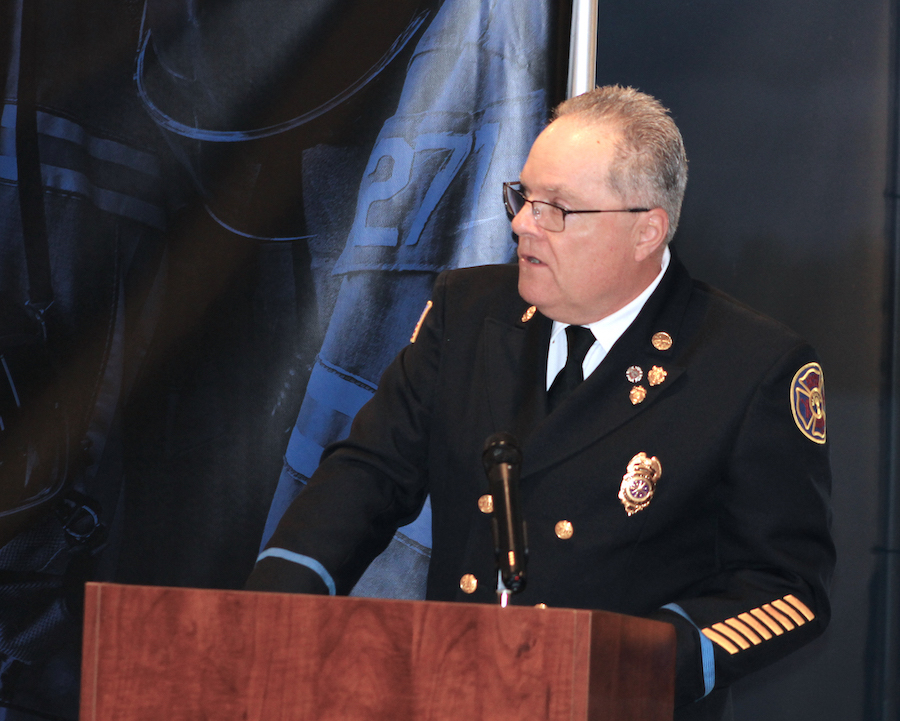Featured News - Current News - Archived News - News Categories
On Friday afternoon, the Niagara County Sheriff’s Office announced, “Niagara County has declared a state of emergency due to the severe weather conditions that are impacting travel and safety. Effective 2 p.m., Niagara County will be upgrading the travel advisory to a full travel ban until further notice.”
On Saturday, NCSO updated the warning accordingly: “The previously issued travel ban is still in effect until further notice. The southern end of Niagara County continues to experience significant weather conditions. Motorists who have not heeded the travel ban have become stranded in their vehicles. Please stay off the roadways so first responders can work to assist those motorists.”
Tops Closed
In addition, Tops Friendly Markets Public and Media Relations Manager Kathy Sautter announced, “The safety of our associates and customers remain our top priority. Due to the continued extreme weather conditions all Erie, Niagara, Orleans, Genesee and Wyoming County Tops stores will remain closed until Monday, Dec. 26. We will reopen at 6 a.m. on Monday, Dec. 26.”
Hochul Provides Update on State's Response Efforts to Winter Storm Impacting Holiday Travel This Weekend
Statewide State of Emergency in Effect as Winter Storm Moves Through New York
NYS Thruway (I-90) closed to All Traffic Between Exit 46 (Rochester, I-390) and Pennsylvania Border; Peace Bridge, Lewiston-Queenston Bridge and Rainbow Bridge border crossings all closed to all inbound traffic
Erie, Genesee, Niagara and Orleans counties Implement Local Travel Bans, Only Authorized Vehicles Can Travel as Blizzard Conditions Persist in Western New York
Gov. Kathy Hochul provided an update to New Yorkers as a winter storm brought significant rain, snow and high winds across the state overnight, and blizzard-like conditions in Western New York. On Thursday, Hochul declared a statewide state of emergency ahead of the event, which went into effect at 6 a.m. Friday. Hochul advised New Yorkers planning to travel this weekend to reconsider, as a significant drop in temperatures Friday afternoon will cause significant flash freezing and icy road conditions.
"This storm has brought a bit of everything we anticipated, and there are thousands of our first responders, emergency management personnel and utility crews out working in the elements to keep New Yorkers safe today," Hochul said. "I'm asking everyone to stay off the roads this evening, as conditions will worsen when temperatures drop across the state later today. Bundle up, stay indoors, and stay safe this weekend."
Today and continuing into Saturday morning, much of the state is expected to see strong winds up to 60 miles per hour or more, as temperatures will drop quickly and significantly – by more than 35 degrees in some regions – causing flash freezing, below-zero wind chills and icy road conditions. This has already impacted conditions in Western New York and is expected to impact the rest of the state by this evening's commute. Winds on Friday and Saturday will be strong enough to cause downed trees and power lines. Lakeshore flooding off Lake Erie and Lake Ontario is possible in flood-prone areas due to rain, snowmelt and strong winds.
Tonight, and continuing through Monday, lake-effect snow will impact the Buffalo and Watertown areas off Lake Erie and Lake Ontario, and strong winds are expected to cause blowing and drifting snow with near zero visibility and localized blizzard conditions. The Buffalo and Watertown areas could see up to 3 feet of snow through Sunday night. Below-normal, freezing temperatures with low wind chills are expected to persist through Monday for upstate regions.
Hochul urged New Yorkers to take all necessary precautions, if traveling this week, and plan ahead for significant weather impacts.
Multiple blizzard warnings, coastal flood warnings, lakeshore flood warnings, high wind warnings, wind chill warnings, and winter storm warnings are all in effect for this weekend in various counties across the state. For a complete list of weather watches, warnings and advisories across New York, visit the National Weather Service website.
New York State Division of Homeland Security and Emergency Services Commissioner Jackie Bray said, "The storm has hit every county in the state, without exception, over the past 12 hours. Remain vigilant today and tomorrow. Before leaving home, check local conditions and listen to the direction of local officials. Tonight, the entire state will experience a deep freeze. It will be dangerously cold no matter where you live in the state and, due to the winds, we expect widespread power outages increasing the danger of the cold. Check on your neighbors and loved ones, and know that the state's emergency response personnel and utility crews across the state are working around-the-clock this holiday weekend to keep you safe."
Agency Operations
•Division of Homeland Security and Emergency Services: The state's emergency operations center and the fire operations center are open and actively monitoring weather reports and incidents across the state to facilitate the state's response to the storm. The Office of Emergency Management and The Office of Fire Prevention and Control have equipment and personnel available to assist with requests.
Across the state's 10 stockpiles, DHSES has the following deployable items to support storm-related needs:
•Department of Public Service: New York's utilities have approximately 7,700 workers available statewide to engage in damage assessment, wire guarding, response, repair and restoration efforts.
DPS staff will track utilities' response, repair and restoration work throughout the event and ensure utilities shift appropriate resources to regions that experience the greatest impact.
As a result of the severe weather, the department has extended its OCS call center helpline hours to 7:30 p.m. Friday to assist New Yorkers in storm response and restoration efforts. The number is 800-342-3377.
•The State Department of Transportation is monitoring weather conditions and is responding with 3,450 supervisors and operators. Additionally, 75 ICS personnel are available to support the response to this event. All affected residency locations will be staffed for 24/7 operation throughout the duration of the event. Staff can be configured into any type of response crew that is needed, such as snow and ice, flood, chipper, load and haul, cut and toss, traffic signal, etc. All available equipment is fully engaged or ready to deploy.
A driving ban has been issued in Erie County and the City of Buffalo; and the following roads in Erie County are closed to all traffic until conditions improve:
Additionally, the Peace Bridge, Lewiston-Queenston Bridge and Rainbow Bridge border crossings are all closed to inbound traffic.
A restriction for trucks "Trucks Use Right Lane" on Interstate 81 from Exit 32 (Central Square) to Exit 51 (Alex Bay) started at noon Friday. Additionally, several roads in the Hudson Valley are closed to do flooding or downed trees. NYSDOT crews are fully engaged in debris removal, assessing the situation, and will reopen the roads as soon as conditions permit.
Regional crews continue to engage in all-hazards preparations. Drainage structures are being checked and cleared of debris. To support response activities in critical areas, a total of 71 staff, including 65 plow truck operators, four supervisors, one assistant manager, one ICS support specialist, 13 plow trucks, two snowblowers, and one grader are being deployed to Western New York and the North Country. They are distributed as follows:
•Western New York
•North Country
The need for additional resources (operators, trucks, mechanics, EOIs) will be reevaluated as conditions warrant throughout the event. Generator stockpiles are being readied for deployment to support dark signal response. Fleet mechanics in affected areas will be staffing all main residency locations 24/7 to perform repairs and keep trucks on the road. Statewide equipment numbers are as follows:
For up-to-date travel information, call 511, visit 511NY.org or download the free 511NY mobile app.
•Thruway Authority maintenance facilities are staffed around the clock and responding to the storm with 678 operators and supervisors statewide. Thruway has shifted and deployed additional staff and equipment from its New York and Albany divisions to support snow and ice operations in Western New York. Deployed resources include large plow trucks and operators. Additional resources are on standby and ready to shift as needed.
All vehicles are banned on the New York State Thruway (I-90) from Exit 46 (Rochester I-390) to the Pennsylvania border, and on the Niagara Thruway (I-190) from I-90 to Exit 22 (Route 62) until further notice.
Thruway statewide equipment numbers and resources include:
Variable message signs and social media are utilized to alert motorists of winter weather conditions on the Thruway. Follow the Thruway Authority on Twitter at @NYSThruway and @ThruwayTraffic, and on Facebook NYS Thruway Authority.
The Thruway Authority encourages motorists to download its mobile app, which is available for free on iPhone and Android devices. The app provides motorists direct access to real-time traffic information, live traffic cameras, and navigation assistance while on the go. Motorists can also sign up for TRANSalert emails, which provide the latest traffic conditions along the Thruway.
•The New York State Police have added extra patrols throughout Western New York and in Jefferson County to respond as needed. All four-wheel drive and specialty vehicles are in service, including utility task vehicles and snowmobiles.
•The Port Authority of New York and New Jersey is monitoring weather conditions. Speed restrictions may be in effect at the bridges, as well as along roadways to and from the crossings. Passengers through the Port Authority's facilities are encouraged to reach out to carriers and airlines directly for the latest information on delays and cancelations. For the latest information about Port Authority facilities, check social media.
•The Metropolitan Transportation Authority is closely monitoring weather conditions to ensure safe, reliable service. MTA employees will be poised to respond to any weather-related issues and remove any downed trees that may fall across tracks.
MTA bridges and tunnels banned empty tractor-trailers and tandem trucks through 8 p.m. Friday. Pedestrian walkways at the Cross Bay Bridge and Marine Parkway Bridge will be closed during this same time period; pedestrian walkways at the RFK Bridge and Henry Hudson Bridge may close depending on weather conditions.
Customers are encouraged to check new.mta.info for the latest service updates, and to use caution while navigating the system.
Safety Tips – Winter Travel Safety
Hochul’s team offered the following:
The leading cause of death and injuries during winter storms is transportation accidents. Before getting behind the wheel, review these safety tips:
√ When winter storms strike, do not drive unless necessary.
√ Make sure that your vehicle is clear of ice and snow; good vision is key to good driving.
√ Always match your speed to the road and weather conditions. Plan your stops and keep more distance between cars.
√ Be extra alert and remember that snowdrifts can hide smaller children.
√ Make sure your car is stocked with survival gear like blankets, a shovel, flashlight and extra batteries, extra warm clothing, set of tire chains, battery booster cables, quick energy foods and brightly colored cloth to use as a distress flag.
√ If you have a cell phone or other communications device such as a two-way radio available for your use, keep the battery charged and keep it with you whenever traveling.
Extreme Temps
√ Be aware of wind chill – wind in combination with the actual temperature – that can cause an increase of heat loss to the human body.
√ Dress appropriately and avoid staying in the cold too long.
√ Wear a hat and gloves, when appropriate, with layers of clothing. Avoid unnecessary exposure of any part of the body to the cold.
√ Drink plenty of warm fluids or warm water, but avoid caffeine and alcohol. Stay active to maintain body heat.
√ Take frequent breaks from the cold.
√ If signals of hypothermia or frostbite appear, get out of the cold, slowly warm the individual and seek medical assistance. Frostbite symptoms include loss of feeling, a white or pale appearance in fingers, toes, ears and nose. Hypothermia symptoms include uncontrollable shivering, slow speech, memory lapses, frequent stumbling and drowsiness.
Heavy Exertion
Heavy exertion, such as shoveling snow, clearing debris or pushing a car, increase the risk of a heart attack. Follow these tips to stay safe after the storm:
√ Stay warm, dress warm and slow down when working outdoors.
√ Take frequent rests to avoid over-exertion.
√ If you feel chest pain, shortness of breath, or pain in your jaw radiating down your arm – stop and seek help immediately.
Power Outages
Winter storms can cause power outages. Review these safety tips before the lights go out so you know what to do in an emergency:
√ Call your utility provider to notify them of the outage.
√ Avoid all downed power lines and report them to your utility provider for repair; assume all downed lines have live electricity.
√ Use only flashlights for emergency lighting – candles pose the risk of fire.
√ Keep your refrigerator and freezer doors shut to keep food from spoiling. When in doubt, throw it out!
√ Do not use a charcoal grill or generator indoors, and do not use a gas stove for heat – they could give off harmful levels of carbon monoxide.
√ Turn off major appliances to prevent damage from a possible surge when the power comes back on – keep one light turned on so you know when power returns.
Home Heating
Heating equipment is one of the leading causes of home fire deaths. Keep loved ones safe by following these important steps:
√ Keep all combustibles at least 3 feet away from heating equipment.
√ Always plug appliances, including space heaters, directly into a receptacle. Never plug appliances into a power strip or extension cord.
√ Make sure there is a working smoke alarm in each bedroom, outside sleeping areas and on every level of your home.
For all non-emergency service needs before, during or after a storm, call 211 or visit 211nys.org. For more safety tips, visit the New York State Division of Homeland Security and Emergency Services Safety Tips website at www.dhses.ny.gov/safety.





























